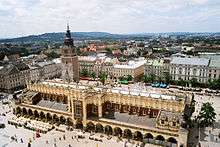Cloth hall

A cloth hall or linen hall (German: Gewandhaus; Polish: Sukiennice; French: Halle aux draps; Dutch: Lakenhal; Swedish: Saluhall) is a historic building located in the centre of the main marketplace of a European town.
A cloth hall contained trading stalls, particularly for the selling of cloth but also leather, wax, salt, and exotic imports such as spices and silk.
Cloth halls were built from mediaeval times until the 17th century.
Poland
In Poland, the most famous existing cloth-hall building is the Kraków Cloth Hall, rebuilt in 1555 in the Renaissance style.[1] Cloth halls also formerly existed in Poznań (at the Old Market Square), in Wrocław (at the site of the street today called ul. Sukiennice), and in Toruń.
Germany
Examples of German Gewandhäuser can be found in the towns of Brunswick, Zwickau and Leipzig (the last now rebuilt as the Gewandhaus concert hall).
Belgium and Netherlands
Examples in Belgium include the Ypres Cloth Hall and cloth halls in Bruges, Leuven and Tournai. The Linen-hall at Leuven is in an early-Gothic style, with baroque addition, and is used today as the University Hall.
The Stedelijk Museum De Lakenhal is in a former cloth hall.
Britain and Ireland
British examples are Drapers' Hall (London), the Piece Hall, Halifax, and Leeds' White Cloth Hall.
In Ireland, Belfast once had a White Linen Hall, and there were linen halls in other towns such as Castlebar and Clonakilty.
Notes and references
| Wikimedia Commons has media related to Cloth halls. |
- ↑ The World's Best Squares, PPS website, Making Places, December 2005
